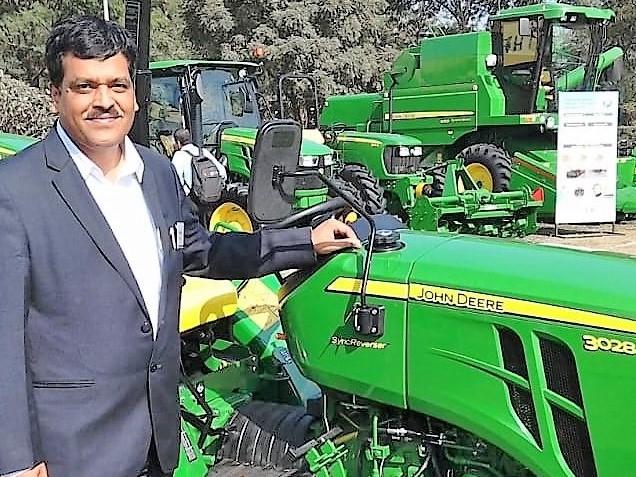‘John Deere is close to double digit market share’

BIS develops standard for Combine Harvester for stubble management
December 19, 2018
Farmers in Bihar opened Repository Accounts with NERL
December 26, 2018The 182-year-old US- headquartered tractor company John Deere is the fifth largest in India. John Deere completes 20 years of operations in India this year. To mark this occasion company launched the four-wheel drive 3028EN tractor in Pune which was also the 100,000th tractor.
On this occasion Satish Nadiger, Managing Director, John Deere India spoke with Shakti Sharan Singh, Consulting Editor, Agri Nation about the future strategies for Indian market
How do you describe this new tractor? How do you think it will support Indian agriculture?
The introduction of the new tractor is in line with the company’s effort to providing Indian farmers with technologically-advanced products that offer a wide range of farm solutions including tractors, harvesters and implements. It is a big day today. It is the 100,000th tractor we have rolled out today. It is the four-wheel drive 3028EN tractor that is targeted at orchard and paddy farming.
We provide John Deere products for a variety of agro-climatic conditions and crop types and this has been key to our growth in India. Our product portfolio serves individual farmers, contract farmers and entrepreneurs who are in the business of custom hiring.
How has been John Deere’s journey in India? Where does it stand today?
Our journey in India began 20 years ago and it’s been quite exiting and satisfactory. Over the past two decades in India, John Deere has invested in state-of-the-art factories, innovative products, and new services to help Indian farmers be more productive.
Today, we are very close to a double-digit market share in India.
With the introduction of advanced product features such as power steering, oil immersed disc brakes, planetary reduction, force feed lubrication and high torque machines, John Deere was the first to introduce these features in India and they have now become industry standard.
We have partnered with crop value chain partners for a holistic farm solution and have also introduced important safety features such as rollover protection and seat belts. Our product advances have been immensely valued by our farmer customers.
How does your company keep pace with the demand from the agri market? How do you foresee technological advancement?
John Deere has its own design and innovation centre in Pune that has not only the responsibility to cater to demand of India but also worldwide. It develops future designs and innovation for utility tractors. Product features such as perma-clutch, front PTO, power reverser, telematics and airconditioned cabin have been welcome features for customers. Adding ‘Green System’ farm implements and John Deere combine harvesters have created wholistic farming solutions.
John Deere Financial Services provides transparency, speed and convenience to support the customers.
The tractor industry will also see the transition to Bharat Stage IV equivalent emission norm even as the car, commercial vehicle and two-wheeler industry will jump to BS-VI. The transition to BS-IV will, however, happen in April 2021 and will not significantly disrupt tractor demand, though the price surge is going to be significant. This is because the change in norms will be for tractors that are powered by more than 50hp engines. More than 90 percent of tractors sold in India have power less than 50hp.
How many manufacturing facilities do you have? What is the capacity?
In 2017, John Deere strengthened its presence in India with the acquisition of the Wirtgen Group, which has a factory in Pune. The Wirtgen Group is the world’s largest road construction company.
Currently, John Deere has tractor manufacturing plants in Pune and Dewas; harvester manufacturing in Sirhind, Punjab; electronics system manufacturing in Pune; engineering and technology centres in Pune, and a parts distribution centre in Nagpur.
The tractor making units have a capacity of 132,000 units from the Pune plant. Our made-in-India tractors and harvesters are exported to more than 110 countries worldwide and John Deere India has been an award recipient of the Export Excellent Promotion Council award for 15 consecutive years.
——————————–


